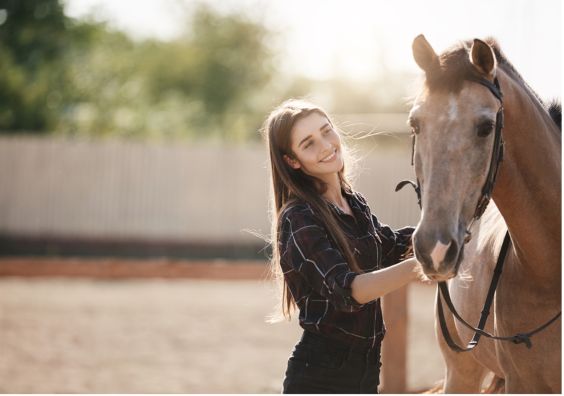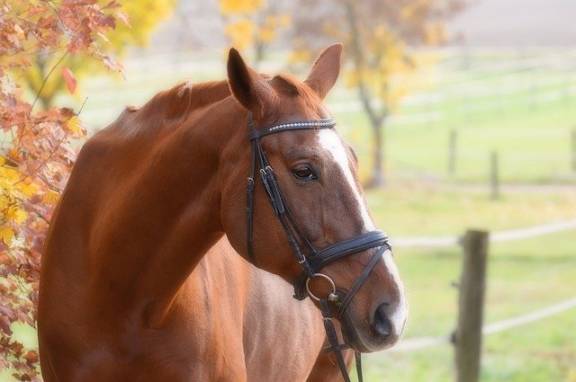Horses are majestic creatures and are known for their amazing physical prowess. Like any other creature, horses need to be looked after daily. Their nutrition should be supervised, and they need to be groomed regularly.
Connect with a verified veterinarian in minutes. Licensed vets are available 24/7 to answer your questions. No need to worry about your furry family member.
If you are bringing home an equine friend, you need to know a few basics before welcoming them. Taking care of a horse is a huge responsibility. You need to be fully prepared and have all the horse care essentials for giving them the ultimate care.
Caring for horses is an important role that cannot be overlooked by any horse owner. This article will delineate all the steps to take for maintaining the health and overall well-being of your new equine companion.
Do Your Research
Equine care is not something we learn in our day-to-day lives. You need to do proper research to equip yourself with the knowledge you will need to care for your horse.
Read various horse blogs, articles, and books to learn about all the requirements of basic horse care. Make a shortlist of all the horse needs like food, ideal living conditions, grooming, and various equipment needed to ensure your horse’s welfare.
Then learn extensively about the fundamentals of each category in the shortlist. You need to know what’s best for your horse. Horses’ diet is very crucial. They also need regular exercises and need to be kept calm. They also need your utmost care, attention, and love.
Basic Steed Needs
Horses are domesticated mammals, and looking after them is a unique experience. Since they are quite different from the usual pets like dogs and cats, many people get intimidated by the responsibility and work of owning one of them.
All you need is to understand the remarkable equine behavior and cater to their basic needs. There are several factors you need to keep in mind to ensure your magnificent stallion is thriving and is in good health.
The minimum requirements of a horse are as follows:
- Horses need pastures that are free from dangers like loose wires, holes, poisonous plants, etc.
- Secure fencing to keep your equine friend within the designated area; opt for safe fencing materials like wood, vinyl, mesh wire, or plastics.
- Your horses need to graze on grass or good-quality hay.
- Horses need to be properly hydrated. They need a limitless supply of clean drinking water. Heat their drinking water if you reside in regions that have sub-freezing temperatures.
- Your steed needs proper shelter from the harsh cold temperatures of the winters, the wrath of the hot summer sun, and wetness from the heavy rains.
- Your horse should be comfortable and sheltered away from the seasonal changes that can make them sick. Having to know where to purchase land for the security of your horse is essential as they also need clean areas that are also dry to lie down and rest properly.
- You need to daily check your horse and look for any injuries or illnesses setting in.
- They need friends. Horses do not like being alone. You can give them companionship by having another horse, pony, donkey, or mule. Alternatively, you can also keep other domestic grazers like cows and sheep. Sometimes your family dog can also provide much-needed companionship.
- Horses need regular grooming and proper care of their hooves.

Review symptoms, medications & behavior to keep your pets healthy with a Vet Online in just minutes.
Ask a Vet Live NowBasic Horse Equipment
Before bringing home your new friend, it is crucial to stock up on all the necessary horse equipment. The last thing you want is not having the required equipment when you find yourself in a situation where you need the equipment.
Here is a comprehensive list of sets of equipment you need for the ideal horse care.
- Feeding apparatus: feeding manger or tub, water trough, heater for water
- Emergency care tools: Equine vet wraps, first aid kits specialized for horses, stethoscopes, etc.
- Barn and pasture maintenance equipment like rakes, wheelbarrows, fertilizers, and pitchforks
- Grooming tools such as horseshoes, hoof picks, ropes, tethers, body brush, horse-friendly bug repellants, combs, and halter leather
- Riding accessories such as sturdy boots, safety stirrups, cushioning pads for under saddles, strong helmets, saddles with cinches, and bridles
As a rule of thumb, have everything you need under each category. Make sure you have most of the above-mentioned tools and accessories to provide the utmost care your equine companion deserves.
Knowledge of Common Horse Diseases
Much like humans, horses also need proper nutrition and diet plans to maintain their health. To take the relevant precautionary measures, you need to know about the common illnesses and threats your horse might experience.
We have put together a list of some common horse diseases you need to be aware of:
Arthritis
This condition is also known as Degenerative Joint Disease (DJD) in animals. This disease inflicts upon your equine’s joints, connective tissues, and cartilage. This occurs due to frequent wear and tear of their joints.
You can take preventive measures by maintaining your horse’s healthy weight. Additionally, give them time to warm up before activities and be sure to cool them off after.
Gastric Ulcers
Ulcers in horses are similar to the ones caused in humans. The symptoms are usually agonizing sores in the gut caused by the disruption of the stomach lining. These painful ulcers have a detrimental effect on your mare’s appetite, behavior, physiology, and overall health.
To protect your horse from such distressing ailment, you should ensure he is fed on a frequent schedule and avoid exerting psychological stress on him. Horses are naturally anxious creatures; therefore, you need to keep them calm and free from stress. You can try incorporating specialized probiotics into their dietary regime as a supplement as well.
Suspensory Desmitis
This is a degenerative disease of the ligaments of the horses. It occurs mostly in the forelimbs and hindlimbs. This impedes the normal mobility of horses and can cause lameness.
Do regular checkups of your horse by a vet to ensure it does not set in and progress beyond control.
Colic
Colic is a serious disease and is known to take the lives of hundreds of horses every year. There are numerous types of colic, and they can occur in any horse. Looking out for any symptoms and timely treatment is the solution.
Indicators of this disease are usually out of character actions like laying down for a long time, lack of appetite, no stool excreted over 24 hours, kicking their abdomen, and other various telltale signs of discomfort. If you notice any of these unusual signs, act fast and call the vet instantly.
While you wait for the vet’s arrival, put the horse in a safe, comfortable space and keep away any feed or hay from the horse’s reach. If your horse is rolling unusually, you can try walking him for a while but with great caution. Follow the vet’s instructions and keep an eye on your mare.
Monitor Your Horse’s Health
It is essential to know the normal health statistics of your horse. You need to keep track of your horse’s health conditions so that you can take preventative steps or get him cured at the right time. Keep in mind that prevention is always better than cure.
Routinely check your horse’s pulse rate, breathing rate, and body temperature. You can estimate these conditions by simply placing your fingers on the large vein under your equine’s cheekbones.
The values are usually higher in young foals. Hence, it is critical to check these rates over long periods for getting a precise estimation.
The values of your horse’s normal levels can slightly vary from the average values. It is crucial to know the normal values to ensure that your beloved mare is healthy and alright.
The normal pulse rate of a horse is 28 to 40 beats per minute. The average equine respiration rate is 8 to 14 breaths per minute. The normal body temperature of a horse varies from 98.5 to 101 Fahrenheit.
Additionally, you should also keep an eye on their general behavior and demeanor. Pay attention and look out for any symptoms and signs of discomfort.
Your horse needs immediate consultation from the vet if he is either incredibly down, restless, or anything unusual like rolling and kicking excessively. Ensure that your stallion’s eyes and nostrils are clear and do not have any discharge.
Regularly inspect your horse’s mouth and nose. The color of your equine’s gums and the interiors of the nostrils should be salmon pink. Inspect the capillary flow by gently pressing on the gums.
Doing so will turn the gums white, and then they should return to the normal pink state within two seconds after being released. Do not forget to pay attention to your horse’s droppings. Horses normally excrete eight times a day.
The stool should be solid, break apart when pressed and have a uniform color. If you notice any large bits of undigested food, change the feed or consult the vet to be on the safe side.
It is vital to be able to tell whether your horse is in good shape or not. Generally, the ribs should not be visible but should be easy to feel when gently pressed.
The rump should appear smooth and healthy from behind. You can tell your horse is underweight if the hips stick out. Overweight equines have rumps that have an apple-shaped appearance. Use a weight tape specialized to measure horses and keep track of your mare’s weight.
It is crucial to monitor the hydration of your foal friend. You can check by pinching some skin of your horse then releasing it. If the skin does not snap back or retain its original state within a second, it indicates dehydration.
Listening to the gut of your steed should also be included in your routine inspection. The normal sound of the gut should be low gurgling and rumbles. Any excessive loud sound might be a concerning symptom. If you hear no sound, then it is a major red flag and can be a sign of colic.
You need to take great care of your steed’s hooves and inspect them every day. Shoe your horse’s hooves to keep them strong and healthy. It is also essential to deworm your foal companion and get him all the necessary vaccinations.
Neigh-ver Leave Your Horse’s Side
Horses are incredibly beautiful creatures. They are innately friendly and love companionship. Give your equine friend the undivided attention and love they deserve.
Connect with a verified veterinarian in minutes. Licensed vets are available 24/7 to answer your questions. No need to worry about your furry family member.

Tom
Tom has always loved to write since he was little - he wanted to be either a writer or a veterinary doctor, but he ended up being a professional writer while most of his works are based on animals. He was born in San Francisco but later moved to Texas to continue his job as a writer. He graduated from the University of San Francisco where he studied biotechnology. He is happily married and a soon to be father!
Review symptoms, medications & behavior to keep your pets healthy with a Vet Online in just minutes.
Ask a Vet Live Now



